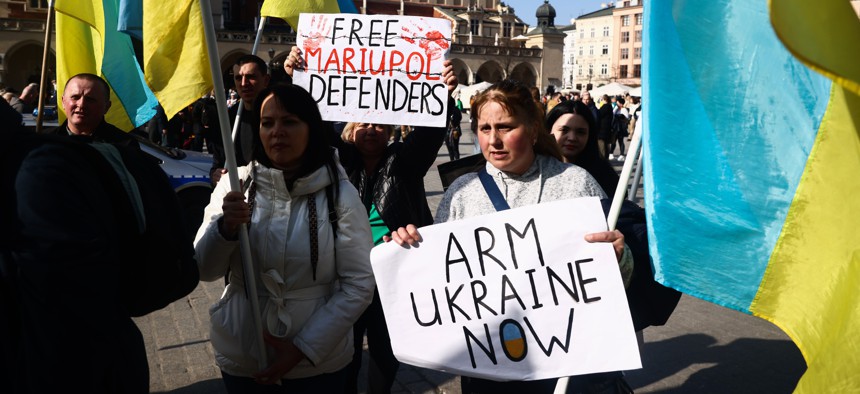
A daily demonstration in Krakow, Poland, seen here on March 3, 2024, is emblematic of continued strong support for Ukraine in Europe. Beata Zawrzel/NurPhoto via Getty Images
Look deeper: Time may be on Ukraine’s side
If Kyiv can hold out through the next winter—a big if—there are trends that run in its favor.
Conventional wisdom is that time is on Russia’s side as Ukraine battles to fend off Moscow’s invasion. Although much remains unclear, it seems certain that if Congress fails to fund more military assistance to Ukraine or if U.S. policy shifts dramatically after Inauguration Day 2025, Kyiv may be forced to sue for peace. However, if these two possibilities do not come to pass, and if Ukraine can hold out through next winter, there are some indications that the tide will turn in Kyiv’s favor.
Perhaps the most significant indication that a longer war would advantage Ukraine is the fact that U.S. defense industry is slowly but steadily reprising its role as “the arsenal of democracy.” For instance, the United States has increased its output of 155mm shells far faster than expected, with plans to increase it further. From a rate of around 14,000 rounds per month before Russia’s full-scale invasion began in February 2022, the United States has exceeded its target of 24,000 rounds by the end of 2023 and is now on track to produce around 36,000 per month by March. Furthermore, that rate should be doubled by this time next year.
European defense industrial production remains hampered by a lack of long-term contracts, an inability to rearrange the priorities of private industry, and competing requirements to fulfill NATO collective defense needs. However, even European defense industry is showing some signs of progress, as Germany announced last week that it will deliver four times as many artillery shells to Ukraine in 2024 as it did in 2023, and that new factories will increase that rate even more starting in 2025. Additionally, European defense manufacturers are developing production facilities for new armaments in Ukraine, and the EU is about to launch a new defense industry strategy as well as a new European Defence Investment Programme to facilitate joint procurement.
Perhaps more importantly, Europeans remain steadfast in their support for Ukraine. Nearly 90 percent of those polled last November continue to support humanitarian aid for Ukraine, and nearly as many favor efforts to welcome Ukrainian war refugees—paradoxical at a time when populist parties across Europe are on the rise, in part due to migration issues. Meanwhile, nearly three quarters favor continued financial support to Ukraine, which was reflected in this month’s agreement by EU leaders to extend $54 billion in financial support to Kyiv over the next four years. Roughly the same number support continued economic sanctions against Russia, despite the high energy costs entailed in such policies. And for a continent sometimes accused of falling victim to its pacifist impulses or shirking its hard security responsibilities, 60 percent favor additional military support to Ukraine.
At the same time, the EU is finally getting serious about responding to not merely China’s role in helping Russia evade sanctions but the roles played by companies in an array of other countries, including Armenia, Kazakhstan, Turkey, the UAE, and Uzbekistan. Tightening existing sanctions is a critical, long-overdue step toward steadily increasing Russia’s costs. Over time, these efforts are likely to become more robust, and given the structural headwinds facing the Chinese economy, even Beijing may increase compliance so as not to lose access to customers in Europe, North America, and elsewhere.
Admittedly, Russia will continue to benefit from having placed its economy on a war footing, something the West is unlikely to do. However, from Russia’s perspective, a forever war is increasingly unpalatable and perhaps unsustainable for several reasons. First, despite its larger population relative to Ukraine, Russia still faces a significant military manpower challenge, especially if it wants to launch a large offensive. Even as Moscow mulls legal changes that would enable it to force prisoners into military service, that population—just like the Soviet-era tanks Russia has been forced to rely upon – remains finite. Eventually, Moscow will be unable to continue sourcing troops from its prisons. A second mobilization is politically difficult, even for Putin, and would likely result in another mass exodus of draft-age men from the country.
Soon, the Kremlin may confront a personnel challenge of a different sort. Vladimir Putin is no spring chicken. At age 71, and in questionable health, he’s years past the life expectancy for a Russian male born in 1953. The longer the war goes on, the more Putin is likely to think about his own mortality and hence his legacy—and the more likely it is that he could depart this world with a festering border war. That’s quite an unappealing legacy for Russia’s longest-serving ruler since Stalin and somebody who purportedly cares greatly about how history may judge him.
To be clear, Ukraine remains in dire straits. It desperately needs more long-term U.S. military assistance, more training, more troops, and a new strategy. Tragically, many of its soldiers and, increasingly, its civilians will perish as Russia wages its unjustified, immoral war before there’s even a chance of a Ukrainian victory. Nonetheless, if Ukraine can hold out through 2024—and if the United States does its part—Kyiv’s odds of eventual victory may increase, not decrease.
John R. Deni is a research professor at the U.S. Army War College’s Strategic Studies Institute, a nonresident senior fellow at the Atlantic Council, and an associate fellow at the NATO Defense College. He’s the author of NATO and Article 5 (Rowman & Littlefield Publishers, 2017). The views expressed are his own.




